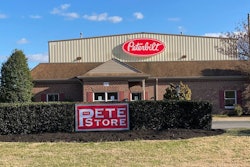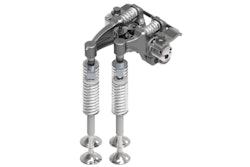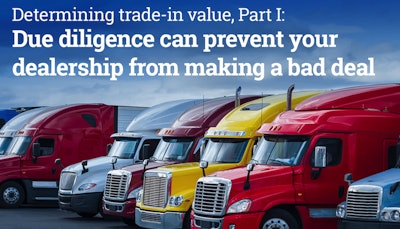
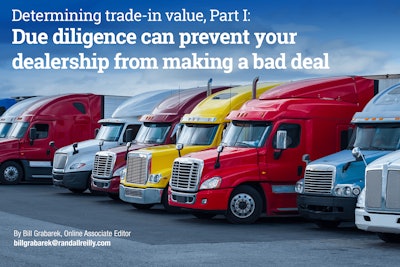
Determining the trade-in value of a used truck or trailer is a tricky proposition. Dealers do their best to incorporate exacting assessment procedures into what many consider an inexact science.
Improperly assessing the condition of a used piece of heavy equipment, misreading the market or underestimating reconditioning expense, among other factors, can cost a dealership when it comes time to resell it.
When determining the trade-in value of a used truck, Rush Enterprises considers the specs, the timing of actual delivery of the traded truck, mileage and condition, says Trey Golden, vice president, used truck sales.
“Timing is important,” Golden says. When a customer orders a truck is when the dealership puts a value on the trade-in. However, it could be months before the customer receives the new vehicle, which is when the dealership takes possession of the trade-in.
 In addition to inspecting the trade, Young Truck Sales checks similar models and suggested retail values to determine what the vehicle will actually sell for.
In addition to inspecting the trade, Young Truck Sales checks similar models and suggested retail values to determine what the vehicle will actually sell for.“You follow how the factory builds are and how far out it might be, which can be anywhere from a couple of months to as long as a year … so what’s it going to be worth when you get it,” Golden says. “If someone places an order for 100 trucks, and that could be 10 per month, so it’s February through November. The same truck is going to be worth a different value based on the timing.”
Chris Miranti, used truck director, Kyrish Truck Centers, stresses the importance of re-inspecting the truck when finally taking delivery.
“Sometimes customers order a truck and the trade doesn’t come in until three or four months after the fact. When it comes back and you don’t re-inspect it, the tires could be different, it could have a check engine light, it could have all kinds of new issues,” Miranti says. “Sales guys are famous for not checking out their trade-in again. Nine out of 10 times, that’s a disaster waiting to happen.”
In addition to inspecting the trade, Young Truck Sales checks similar models and suggested retail values and then comes to a determination of what the vehicle will actually sell for, says Sales Director Justin Candea.
“We try to give a very fair number because we still want to do as much as we can as far as deals go, but the customer has to be willing to be realistic in the trade price if the market is down,” he says.
When determining the value of trailer trade-ins, the perfunctory factors are age, condition, hours for refrigerated trailers, market demand and current inventory, says Adam Witman, used trailer manager, Utility/Keystone Trailer Sales.
Furthermore, Utility/Keystone is a member of the 20 Group consisting of other Utility dealerships. Each location from around the country puts together a list in April and September every year of what they’re paying for trailers.
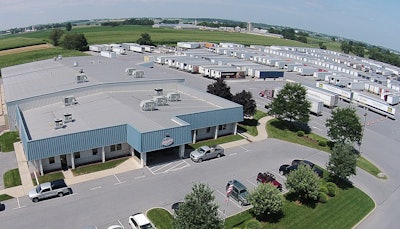 Utility/Keystone has a combined 120 years of experience in three full-time buyers, a vice president of sales and used trailer manager, all of whom buy trailers.
Utility/Keystone has a combined 120 years of experience in three full-time buyers, a vice president of sales and used trailer manager, all of whom buy trailers.“It gives you a snapshot across the country of what other dealers are paying for trailers [in wholesale value] and that helps a lot,” Witman says.
At the dealership level, Utility/Keystone has three full-time buyers, a vice president of sales and Witman, all of whom buy trailers.
“We have five people with a combined 120 years of experience in the industry who will sit down and look at equipment and we’ll share what we’re thinking and from there we’ll come up with a fair number,” he says.
Kicking the tires
A proper assessment of the trade-in is critical in determining its value, which means the assessment has to be thorough.
Miranti is a self-described “stickler” when it comes to getting an accurate, extremely detailed appraisal from his sales representatives when assessing a trade-in. Comprehensive training on what to look for “can make or break you,” he says.
Miranti says the assessment should include any number of potential issues, such as smoke coming out of the exhaust, which could signal a bad diesel particulate filter (DPF); head gasket or transmission leaks; water in the oil; oil in the coolant; even tread on the tires; etc.
Then there are the truck’s features: “Does it have full locking rear ends? Does it have a double bunk versus a single bunk? Are the tires virgin or recapped? There are so many specifics,” he says.
Oftentimes, Young Truck Sales will have to assess a truck that isn’t on the lot, relying on the VIN and a lot of photos, Candea says.
 When determining the trade-in value of a used truck, Rush Enterprises considers the specs, the timing of actual delivery of the traded truck, mileage and condition.
When determining the trade-in value of a used truck, Rush Enterprises considers the specs, the timing of actual delivery of the traded truck, mileage and condition.Once a trade-in arrives on site, the overall condition of the truck, including the tires, is looked at and computer diagnostics are run to, for example, check codes and when the last regen was run “because a lot of the issues we run into are aftertreatment-related,” he says. On many occasions, the DPF filter will be taken out and inspected to “see how it’s been treated and make sure there’s been no tampering with it because we’ve had those cases,” Candea adds.
At Rush Enterprises, “We’ll ask for the local management team to do an appraisal by getting us all the information on the truck and take photographs,” Golden says. Then, reconditioning costs are estimated and retail price and trade-in value are determined.
Utility/Keystone looks for normal wear and tear on a trailer, such as dents or gouges and the condition of the brakes and tires.
“One thing, with refrigerated trailers, the hours on the unit would be very important. That’s like miles on a car,” Witman says. “Trailers from owner-operators typically have a higher residual value than a fleet trailer because they typically are in better condition with more options.”
Be sure to read Part II in tomorrow’s Trucks, Parts, Service newsletter.




